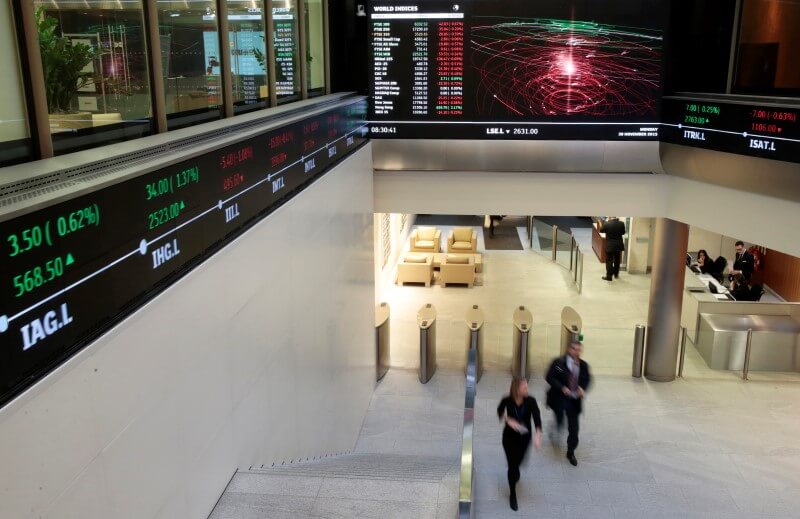By Mike Dolan
LONDON (Reuters) – Voter rebellions? A protectionist wave? Looming recession? Islamic militancy? Perhaps the biggest shock to world markets now would be if central banks met their inflation goals. After nearly 10 years of near zero or even negative interest rates and trillions of dollars in new cash stimulus, the world’s top central banks have just about kindled a spluttering, sub-par expansion with jobs to boot. But they have failed to get wages growing for large parts of the population or to sustain consumer price gains above targets of about 2 percent for any length of time.
Financial markets have stopped believing they will – in some cases not for the remainder of our working lives.
Inflation expectations embedded in interest rate derivatives and inflation-linked bond markets are below target to at least 2026 and even, where visible, 2046. Nominal sovereign yields out three and even five decades into the future for Japan, Germany, Britain, France and Switzerland are all below these targets too. Some suspect the extraordinary bond-buying intervention used to flood banks with all that newly-minted cash – still in full flow in Japan and the euro zone, and possibly relaunched in Britain this week – has skewed all pricing to make it unreliable. But the U.S. Federal Reserve stopped its ‘quantitative easing’ almost two years ago and has been no more successful in either meeting its inflation targets since or in convincing its markets it will mange to do so over time. The Fed’s favored household inflation gauge – the core Personal Consumption Expenditures index – has remained stubbornly below a presumed 2 percent goal now for eight years.
“Inflation expectations at 2 percent would be bordering on irrational at this point given the Fed’s inability or unwillingness to achieve its target year after year,” wrote Morgan Stanley economist Ted Wiseman, adding his forecast for this year and next meant there would be a full decade of misses. Failure to generate enough economic activity to get wage and inflation expectations rising clearly matters to governments, households and business for a whole host of reasons – coaxing the public to buy goods today rather than saving for tomorrow, getting private firms to invest in future production and innovation, debt sustainability and even political stability. And for financial markets, a deeply-embedded belief that central banks will not meet their targets over the coming decades has led to extraordinary changes of behavior and herding that mean any sign of success could be seismic. With monetary stimuli now looking inadequate on their own, governments may resort to a combination of budget spending and monetary pumping to get a grip.
Japan nodded to that tilting policy mix this week with plans for 7.5 trillion yen of new government spending – likely funded by the sale of 40-year bonds, just after the Bank of Japan said on Friday it would expand purchases of equities rather than bonds. That change of policy tack may jar ossifying market expectations. The 25 basis point rise in 10-year Japanese government yields this week – the biggest such move in three years – is eye-catching as a result. INFLATED ASSETS
But how exposed are world markets to shifting assumptions?
Equity prices have been nudging record highs again even though underlying corporate earnings growth has stalled and global money managers polled by Reuters last month are drifting away, their holdings of bonds and cash exceeding equities for the first time since the credit crisis seven years ago. And yet, bonds too have never been more expensive, with record low yields undermining their critical fixed income function. German 10-year Bunds now have zero percent coupons and that means any move higher in yields involves significant losses on this supposedly ‘risk free’ asset. Put another way, if markets believed the ECB would meet its near 2 percent target over those 10 years and 10-year Bund yields at least matched that level, then Bund holders would suffer a capital hit of over 20 percent. Fitch estimates that a rapid reversion to just 2011 levels for almost $38 trillion of investment-grade government bonds could crystallize market losses of as much as $3.8 trillion.
So what gives? An assumption central banks will continue to try but ultimately fail to meet inflation goals is akin to presuming they’ll prevent another recession but not get enough growth to push up prices. In that world anaesthetized from the sort of steep equity drawdowns associated with economic contraction, simple yield plays between assets makes the 3.6 percent dividend on European equity or even the 2 percent on U.S. equivalents sparkle next to near zero or even negative government bond yields. Citi’s estimate of the global ‘equity risk premium’ – adding expected growth to current dividend yields across major developed economies and comparing it to an average 10-year government bond yield – is a whopping 5.3 percent. That’s far above 25-year averages of 3 percent and most other bull market or bear market peaks except 2009.
With conservative investors now relying on equity for income and playing bonds for capital gain, the shock of policy success could be sizeable by squeezing that ERP from the bottom up and whipping away a prop for already pricey, jaded stocks. “Markets are very doubtful that policymakers will be able to meet their inflation goals,” said Citi’s global equity strategist Robert Buckland. “The surprise from here would be that they actually do achieve their goals.” (Additional reporting by Jamie McGeever; editing by John Stonestreet)
The ‘what if’ spooking markets: policy success

By Mike Dolan
















